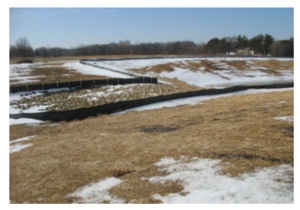
Perimeter control
Perimeter control
National Pollutant Discharge Elimination System/State Disposal System Permit Guidance on the use of perimeter control
Perimeter control is a method of sediment control best management practices (BMPs) that acts as a barrier to retain sediment on a construction site. Sediment control BMPs are intended to slow and hold flow, filter runoff, and promote the settling of sediment out of runoff, via ponding behind the sediment control BMP.
What is required by the National Pollutant Discharge Elimination System/State Disposal System Construction Stormwater Permit?
The National Pollutant Discharge Elimination System/State Disposal System (NPDES/SDS) Construction Stormwater Permit (Permit) requires that certain sediment control BMPs are utilized to minimize sediment from leaving a construction site. Some sediment controls, such as ditch checks, may be needed to promote sheet flow and prevent rills and gullies from forming on steeper slopes or ditch bottoms. The Permit also requires additional sediment controls to be utilized at the base of soil piles to contain sediment. Sediment controls located at down gradient boundaries of the construction site are referred to as “perimeter controls”. The location and type of perimeter control BMPs, along with other sediment control BMPs required by the Permit, must be identified in the site’s Stormwater Pollution Prevention Plan (SWPPP).
The perimeter sediment control BMPs must be established on all down gradient perimeters and up-gradient of buffer zones before any land disturbing activities begin. These BMPs shall remain in place until final stabilization has been established. If the down gradient perimeter controls are overloaded, additional up gradient controls may be necessary to prevent further overloading. The selection of perimeter control BMPs is the permittee’s decision, but it must be effective at keeping sediment on the site. If it is determined through inspection that the selected method is not effective, then the BMP must be upgraded to a method that is effective at keeping sediment on the site.
The timing of the perimeter control installation may be adjusted to accommodate short term activities such as clearing and grubbing, and passage of vehicles. This means these BMPs may be taken down as necessary to allow vehicle on and off areas of the site or to allow work such as utilities to be installed through the perimeter BMP. These short term activities must be completed as quickly as possible and the perimeter control BMPs must be reinstalled immediately after the activity is finished. All perimeter control BMPs, however, must be in place before the next precipitation event, even if the activity is not complete. Click for full details of the NPDES/SDS Permit requirements,
For more information and illustrations, see the following pages.
This page was last edited on 8 December 2022, at 17:18.
